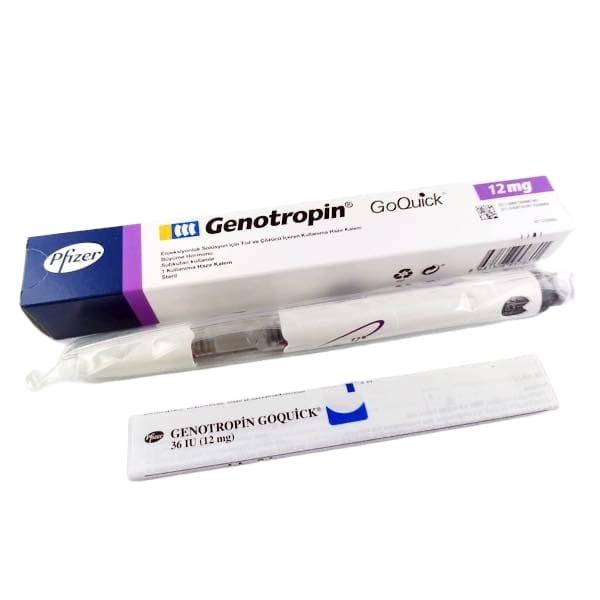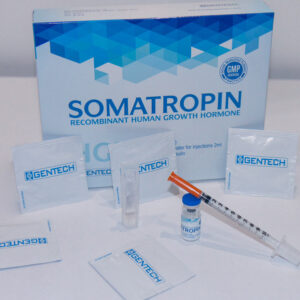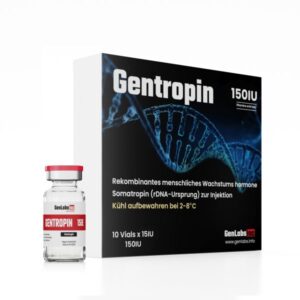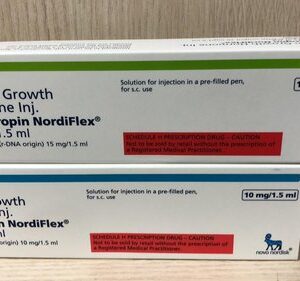HUMAN GROWTH HORMONE
Human Growth Hormone is perhaps one of the newest compounds used by athletes and bodybuilders looking to obtain a larger edge in the area of physique and performance enhancement. It must first be made clear that Human Growth Hormone is not an anabolic steroid. Human Growth Hormone is what is known as a protein hormone (or a peptide hormone) that is naturally and endogenously produced by the human body and secreted at the pituitary gland. The neurosecretory cells of the hypothalamus release a hormone known as GHRH (Growth Hormone Releasing Hormone, AKA Somatocrinin) and another hormone known as GHIH (Growth Hormone Inhibiting Hormone) into the pituitary gland, which then manufactures and releases its Human Growth Hormone storage into the bloodstream. Human Growth Hormone belongs to the Somatotropin family of protein hormones, making it a very close relative to the hormone Prolactin, which also belongs to the Somatotropin family of hormones. The total Somatotropin family includes: CSH1, CSH2, CSHL1, HGH (Human Growth Hormone), PRL (Prolactin), and hGH-V. Human Growth Hormone consists of a structure of 191 amino acids.
Human Growth Hormone, as its name would suggest, is an important hormone in the role of many different growth mechanisms and functions in the human body. However, Human Growth Hormone’s activity is not limited to just this function – it possesses a whole myriad of different functions and effects on many different processes of the body, including regulating certain aspects of the metabolism, providing cellular regeneration and growth, as well as healing and repair and more. Many of Human Growth Hormone’s functions are well known, but it also possesses properties and functions that are still as of yet known or not very well understood. Human Growth Hormone’s primary effects on growth functions of the body are in three primary areas: bone growth, skeletal muscle growth, growth of internal organs, and the healing/growth/repair of connective tissue such as tendons, ligaments, and joints. In terms of its effects on metabolism, it supports the efficient functions of protein, carbohydrate, fat, and vitamin/mineral metabolism.
Within the medicine, Human Growth Hormone has been used successfully as a treatment to many different types of disorders and ailments. The first and foremost use of HGH medically is for the treatment of pituitary deficient dwarfism, a condition in which individuals do not grow properly due to a lack of endogenous Human Growth Hormone production. This is most frequent during childhood or adolescence, where synthetic Human Growth Hormone is administered in order to increase growth as much as possible prior to the middle stages of adolescence whereby the potential for growth becomes increasingly limited. It is also utilized for similar conditions in adults as well. Medically, Human Growth Hormone is also utilized for the treatment of Human Growth Hormone deficient adults, whereby adults produce insufficient levels of GH, and synthetic exogenous Human Growth Hormone is administered in order to restore levels into the normal range (preferably into the range of what a young adult would possess so as to restore youthfulness and exhibit anti-aging effects so commonly attributed to Human Growth Hormone). Lastly, exogenous Human Growth Hormone therapy is used in the treatment of AIDS/HIV related muscle wasting (or as a result from many other diseases). There are other conditions that Human Growth Hormone is occasionally utilized for treatment as well, such as the promotion of accelerated healing in burn victims.
GROWTH HORMONE EFFECTS IN DIFFERENT TISSUES
HGH has displayed a vast, broad, and diverse range of effects. It is a hormone that has been found to be anabolic in muscle tissue, demonstrated to increase both the size (hypertrophy) and number of muscle cells (hyperplasia). The interesting fact about Human Growth Hormone is that its ability to generate a far greater amount of hyperplasia over hypertrophy is very favorable among athletes and bodybuilders, as an increased number of muscle cells (hyperplasia) over an increase in the size of muscle cells (hypertrophy) is always favored due to the fact that newly created muscle cells remain permanently (more or less). The size gains as a result from hyperplasia will remain indefinitely following these growth effects.
Human Growth Hormone also possesses the effect of promotion of cell regeneration, re-growth, and healing in every single cell type in the human body with the exception of the majority of cells in the eyes and brain. This is beneficial for individuals who possess debilitations and/or diseases in which organ failure is a possibility, but organ transplants are not an ideal option. The use of Human Growth Hormone can effectively heal, for example, and individual who possesses kidney or liver failure and at the very least maintain normal functioning of these organs through its cellular regeneration and growth capabilities. This is also why HGH will generally result in larger organs (due to the increased cellular growth), and is a perfect example of why individuals with various organ failure typically possess organs that are far smaller (due to the extensive cellular death of the organ’s cells) than individuals who otherwise possess healthy organ function.
Human Growth Hormone’s metabolism effects include its major effect of shifting the human body’s preference of energy source from carbohydrates to lipids (fats). As a result, Human Growth Hormone use will commonly result in rising blood sugar levels (known as a diabetogenic effect). This effect is, of course, dose-dependent and directly correlated with doses. Excessive Human Growth Hormone doses or periods of use can possibly result in the beginning of type-2 diabetes. However, through its manipulation of energy sources from carbohydrates to body fat as the preferred source, the fat loss effects can be very dramatic and as a result will also decrease cholesterol levels. Human Growth Hormone also tends to deplete potassium, phosphorous, and sodium levels, which should be kept in mind by the user (proper supplementation with these minerals is advised especially with higher Human Growth Hormone doses). Human Growth Hormone also tends to have a lowering effect on circulating levels of T3 (thyroid hormone), which can temporarily disrupt metabolism. Once again, this is a dose-dependent effect.
Overall, Human Growth Hormone acts upon receptors located on muscle, cells, bone, and fat tissue, signaling these different cell and tissue types to engage in growth and fat loss. Its effects on metabolism also result in an increase of hepatic (liver) gluconeogenesis (creation of glucose), and its role in preventing cells from utilizing this fuel source in favor of lipids instead. The fact of the matter is that Human Growth Hormone’s effects are all essentially governed by the protein hormone IGF-1 (Insulin-like Growth Factor 1). GH travels to the liver where it signals the liver cells to begin production and secretion of IGF-1, a very potent growth hormone that has been proven to be very anabolic in muscle tissue. It must be understood, however, that IGF-1 possesses properties and effects that are very much the opposite of Human Growth Hormone (for example, IGF-1 tends to increase fat retention and increase glycolysis (consumption of glucose as fuel).





Reviews
There are no reviews yet.